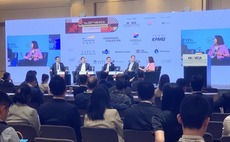
Q&A: Foundation Private Equity's Jason Sambanju
Having made his name in Asia secondaries at Paul Capital, Jason Sambanju struck out on his own in 2017 with Foundation Private Equity. He explains why there is room for a local GP dedicated to LP-style deals
Q: What can you bring to secondaries in Asia that the market doesn't already have?
A: We are a regional, homegrown secondaries firm that only does LP-style secondaries. All our brethren straddle two worlds – they do direct secondaries and LP-style secondaries. We think there is a market for a platform that exclusively works with GPs, rather than competing with them or sitting in an adversarial seat in terms of buying their positions. At the same time, we think the mid-market is underserved. Plenty of global firms target deals of $75 million and above; there aren't many people below that level. Asia is fundamentally a mid-cap market.
Q: Other investors might claim that diversification into direct deals is necessary because that's where the best returns are…
A: There might be a temptation to do direct deals – and if you look at our team, we are all ex-direct investors – but you must balance that with what you want to achieve in the long term. Most of our deal flow comes from GPs, and we want to position ourselves whereby managers understand we only want to be their LP. We are not going to compete with their capital or provide a liquidity solution for their fund while at the same time trying to buy a certain asset and keep it for ourselves. We might miss out on opportunities because we are committed to being an LP, but we want to communicate a clear and consistent message about what we will and will not do.
Q: Is there evidence of secondary investors competing with GPs for deals?
A: We have heard from market participants in Asia that there is confusion or even frustration when they engage with some of our peers because it isn't clear to them what the basis of the engagement really is. We can't say for sure, but apparently, there have been situations in which one of our brethren has invested in a fund, and then a direct investment opportunity emerges, and they leverage their position to get access to it, undermining their own GP in the process. We all respond to economic incentives. If a secondary investor doesn't pay a GP fees and carry, that investor would make more money for the same given price, that is simple math. We make our choices, and our competitors make theirs.
Q: A GP might be talking to an LP about a fund restructuring, share information about its performance, capabilities and pipeline, and the LP goes around the corner and pilfers the pipeline?
A: That's the perennial challenge a lot of GPs face when they engage with LPs. It's a reality of the broader private equity industry that many LPs are moving into the direct space, pursuing more GP-like roles. They do it for different reasons. Some don't want to pay fees and carry to the GP. Others, such as pension funds, are under pressure to narrow their net-gross spread. They are not necessarily looking to undermine GPs, but they operate along a spectrum. I think over time it will become clear to the market which LPs manage conflicts well and which do not. We decided to keep things simple, so everyone understands what we do.
Q: Can your strategy scale?
A: Once we close a deal and acquire a portfolio, it is the GP that sits on the boards, interacts with the management teams, and drive the exits. A lot of the heavy lifting we do is on the front end – identifying deals, underwriting, negotiating the right price. In that sense, we are scalable in the same way an LP is scalable. We would rather scale by completing more deals rather than getting into direct investing. We are looking to do 2-3 per year right now. By Fund III or IV, could we be doing 6-9 per year? Probably. We won't necessarily do larger deals either. Our check size range is $10-40 million. We want to be in the lead position, so a $30 million check means we could lead a $100 million deal. We could participate as a syndicate partner, so there is a lot more flexibility in that.
Q: At Paul Capital, you led the spin-out of Bank of America Merrill Lynch's Asia PE team and portfolio, which ultimately became secondaries specialist NewQuest Capital Partners. That was 10 years ago. Are you surprised by how the market has grown since then?
A: This isn't the first time I've thought about going out on my own and setting up an Asian secondaries firm. I considered it just before Paul Capital shut down its global investment operations in 2014, but I decided the market wasn't mature enough to support a full-fledged regional business. The ideal scenario was a $200-300 million fund that would pursue fund restructuring-type deals. When NewQuest came in and established itself, that really influenced how people thought about the Asian secondaries market. Some of the deals done in the early part of the decade didn't have great outcomes, which made people reluctant to put money into the space, but there was a post-NewQuest wave. Maybe from 2014 onwards, it picked up. Before that, it was one deal a month. Now we see one every two weeks. When you start reviewing 20-30 deals per year, that's when you think you can pick out the two or three you really want to do.
Q: Where do you see the most opportunities within Asia?
A: Across Asia, there are many variations of the same theme. GPs are taking advantage of secondary investors' appetite to deploy capital and try different things. Most of the deal flow we've been looking at has been India and China, with some in Southeast Asia. There are plenty of end-of-life situations where funds are in the expiry phase but still hold assets. While some portfolios have performed well during COVID-19, others have not, so timelines are being extended. But deals can also emerge much earlier in a fund's life. We are looking at one right now where the GP needs four more years and doesn't want to put the current fund under pressure. At the same time, we are seeing situations where GPs that have raised funds in domestic markets want to access the much larger US dollar market. It's not just renminbi-to-US dollar conversions, but also Indian GPs. In India, the division between dollar and rupee was less clear than in China – many managers raised two sleeves within the same fund, so dollars and rupee went into the same deals through parallel structures. However, the Indian market is relatively small in terms of LP capital. When a GP reaches a certain scale, it must look at the dollar market.
Q: What issues do you face when backing managers that are institutionalizing their LP bases?
A: Often, in their desire to build a business, GPs think on their feet and accede to certain demands from LPs. They may end up with different pools of capital that can operate in a conflicted way. A lot of GPs can bootstrap to Fund II, but when Fund III comes around it could become a real issue. We can help make those conflicts less of an issue by consolidating those different pools into one fund. The GP can then go to the market and say, ‘These are the conflicts, this is how we addressed them, and now we are 100% focused on investing our institutional investor-backed funds.' We take a global secondary LP approach in terms of underwriting and putting in place the right legal mechanisms, but we have adapted it to the Asian market.
Q: As a first-time fund, Foundation has brought in Tikehau Capital as a strategic partner. What led to this?
A: Fundraising has been the best experience in that I now know how hard it is to raise your own fund. When I speak to GPs about restructuring their funds, I appreciate the difficulties in raising money, and that changes the tone of the conversation. The discussions with Tikehau came about through a mutual introduction. They have a history of helping GPs catalyze their fundraising or putting GPs into business. They were interested in what we were doing and thought they could help us accelerate the growth of our platform.
Q: How exactly will they help?
A: The synergies are threefold. First, we are plugging ourselves into an organization that has the right systems in place to grow AUM at speed and to scale. Having the right systems in place is crucial to attracting institutional capital. And once you do this for yourself, screwing in every nut and bolt, you realize the challenges that come with building that infrastructure from scratch. They bring an entrepreneurial mindset but one that has transitioned to being entrepreneurial combined with an institutional backbone. Second, we are looking to access investors and Tikehau has been successful in doing that. Having an LP that is an investor rather than just an asset allocator makes a real difference in this respect. Finally, with secondaries, you execute locally but you need a global perspective. We have access to a brain trust that doesn't just focus on the narrow scope of Asia.
Latest News
Asian GPs slow implementation of ESG policies - survey
Asia-based private equity firms are assigning more dedicated resources to environment, social, and governance (ESG) programmes, but policy changes have slowed in the past 12 months, in part due to concerns raised internally and by LPs, according to a...
Singapore fintech start-up LXA gets $10m seed round
New Enterprise Associates (NEA) has led a USD 10m seed round for Singapore’s LXA, a financial technology start-up launched by a former Asia senior executive at The Blackstone Group.
India's InCred announces $60m round, claims unicorn status
Indian non-bank lender InCred Financial Services said it has received INR 5bn (USD 60m) at a valuation of at least USD 1bn from unnamed investors including “a global private equity fund.”
Insight leads $50m round for Australia's Roller
Insight Partners has led a USD 50m round for Australia’s Roller, a venue management software provider specializing in family fun parks.







